About 20 years ago I was in a kind of partnership with another film historian who told me that, no, there wasn’t a market for a book on pre-code movies. I can only wonder what he thinks today after MGM has released three sets of pre-code movies and Universal just put out their first. Either I was ahead of my time, or he was just simply wrong.
For those not familiar with Hollywood history, the term pre-code movies generally refers to films made during the first few years of talking pictures—roughly 1929-1933. Yes, there were talkies before 1929, but 1929 was the year the medium became standard. And, yes, there were a few pre-code films as late as 1934, but that was the year that the so-called “Production Code” came into its own thanks to the Catholic Legion of Decency and the Breen Office. The latter was the official censorship board for motion pictures—instituted by the studios themselves.
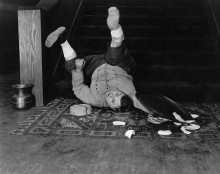
Movie censorship in the United States has always been—and remains—a tangled web of peculiar self-policing policies. Although individual states often had censor boards, there’s never been a government controlled censor policy for movies in America. In the early days—pre-1923—there was no censorship of any kind. That changed less because of the content of the movies than because of public scandals involving the personalities of the era—especially, the Roscoe “Fatty” Arbuckle rape trial (though Arbuckle was exonerated) and the death of matinee idol Wallace Reid from an overdose of morphine.
Events like that brought the moralists out in force, and fearing the prospect of actual government censorship, Hollywood set up the Hays Office—named after Will H. Hays, a former head of the Republican National Committee and Postmaster General. Hays was made president of the Motion Picture Producer and Distributors of America (MPPDA), which was the original name of what we now call the Motion Picture Association of America (MPAA)—you know, the folks who rate movies.
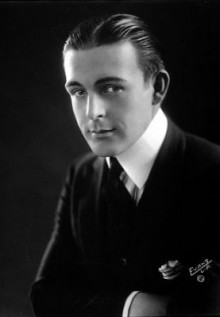
The Hays Office, however, wasn’t terribly effective. But it didn’t need to be, since it was mostly for show. The filmmaker most impacted by it was probably Cecil B. DeMille, who, being the canny showman that he was, quickly realized that he could still traffic in marital melodrama, bathtub scenes, and gleefully sadistic violence if he dressed it up in Biblical clothes. It’s hardly coincidental that DeMille’s first big foray into the realm of religious epic, The Ten Commandments, came along in 1923. Others profited from his lesson. (Modern viewers are often surprised to find topless women in Fred Niblo’s 1926 Ben Hur.)
It wasn’t until 1930 that “The Production Code” came into being, but studios—tussling with the dawn of sound and the Depression—paid only the slightest attention to it. That changed in 1934 when the Legion of Decency started threatening boycotts and things started edging toward governmental censorship on a federal level. Only then did the studios really give themselves over to the “guidelines,” which came close to emasculating the movies for years. But in that early sound era, it was—and is—remarkable to see what the movies got away with.
Conventional movie history put forth the idea that Clark Gable saying, “Frankly, my dear, I don’t give a damn,” was the first time anyone swore onscreen. More correctly, it’s the first time it was allowed under the code. It wasn’t all that rare in the early days of sound. “Damn” and “hell” crop up pretty frequently between 1929 and 1934. Without recourse to research, I can rattle off several titles—Sunny-side Up (1929), The Green Goddess (1930), Mammy (1930), The Old Dark House (1932) and Elmer the Great (1933)—that come under that heading. We could also add the use of the word “fag” in Little Giant (1933) and the only case I can think of where “Jesus Christ” is used as an expletive in a 1930 cheapie called The Costello Case. (This last, however, was from Sono-Art World Wide and may have been outside the MPPDA jurisdiction, i.e., it may not have been submitted for approval.)
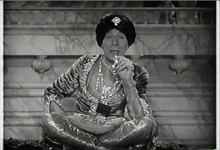
I first became aware of these films when I was in high school—long before anyone had bothered to put a name to them as a collective group. At 16 I was pretty delighted—and a little shocked—to find George Arliss defeated by his enemies in his lust for the heroine of The Green Goddess, calmly lighting a cigarette and rationalizing, “Well, she’d probably have been a damn nusicance,” for the film’s final fade-out.
Of course, it’s not all about swearing. There’s much more to pre-code movies than that. The topics are often racier. Wrong-doing is not always punished (a big point with the code). Innuendo is more pointed. More skin is shown. Violence is surprisingly violent. Jokes are raunchier. And there’s more skin and a lot more sex. What all this really does is smash the myth of some earlier, more innocent time. That’s an idea that the code fed to us—one that had very little to do with reality, but with the idealized reality as envisioned by the authors of the code. The desire wasn’t to reflect life, but rather to help shape it.

These days, the pre-code era is being looked at collectively, and that’s a good thing, even if the approach to it has some serious shortcomings. With four sets of pre-code movies out, you’re still getting no more than a snapshot because so many of the more flamboyant excesses of the era are housed in other forms. For example, one of the more outre films of that time, DeMille’s The Sign of the Cross (1932) is part of a DeMille set. Until you’ve seen Charles Laughton’s campy Nero, Claudette Colbert’s bath in asses’ milk (watch for the nipples!) while she makes a lesbian pass at a servant, and the arena scenes with Christians at the mercy of man-eating elephants and a naked girl menaced by Charlie Gemorra in a gorilla suit, you really haven’t had the pre-code experience.
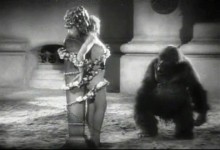
And what of Miriam Hopkins’ side nudity as she comes on to Fredric March’s Dr. Jekyll in Rouben Mamoulian’s very sexualized Dr. Jekyll and Mr. Hyde (1932)? That’s out paired with the tamer 1941 version of the story on a single disc. Similarly, the violent—and often perverse—gangster films have their own niche, but belong to the same unfettered time. It’s unlikely that Howard Hawks’ Scarface (1932) is going to find a home in a pre-code set, since it’s already available, but its wholesale violence—not to mention the incestuous nature of Paul Muni’s obsession with his sister—is pure pre-code.
The musicals of the era largely get lumped into their genre. That’s reasonable, but films like 42nd Street (1933), Golddiggers of 1933 (1933) and Footlight Parade (1933) are pre-code down to the taps on the dancers’ shoes. Flying Down to Rio (1933) is rightfully part of an Astaire-Rogers set, yes, but it boasts lines like, “Say, what have these South Americans got below the equator that we don’t,” and chorus girls in very transparent blouses. International House (1933) is a riot of see-through costumes, double-entendres and even Cab Calloway singing “Reefer Man,” but it’s in a W.C. Fields set.

Even though she only hit movie screens in 1932, there’s the veritable poster-child for pre-code movies, Mae West. She made three and a half movies that are the essence of pre-code film. Night After Night (1932), She Done Him Wrong (1933) and I’m No Angel (1933) are unvarnished examples. Leo McCarey’s Belle of the Nineties (1934)—probably her best made film—nearly qualifies, but it fell under the code a bit. In fact, it was originally supposed to be called It Ain’t No Sin, but that was deemed unacceptable. Legend has it that some clever PR person had 100 parrots trained to say, “It ain’t no sin,” on cue before the change was made. Even allowing for the probable hyperbole of the number of birds, that put a lot of livestock out of work—and probably cost the poor boob who came up with the idea his job.
What we’re getting by way of the box sets are really orphan films. Regadless of their individual merits—which are variable—the collections are being cobbled together from movies that are otherwise largely unmarketable. I’m not complaining, mind you, I merely think it should be realized that these movies do not represent pre-code by themselves. They’re only a part of it.
Nowhere is this more evident than in Universal’s recent Pre-Code Hollywood Collection, touted as “6 shocking films from the era before rules.” Aside from the fact, that it’s amusing that all of these movies were made by Paramount and are merely Universal (or more correctly MCA) acquisitions from a 1958 sale for TV distribution, the most notable aspect is that this is about the only imaginable grouping that would be marketable. Even when the films have stars with actual name value today—Cary Grant in Hot Saturday (1932) or Fredric March in Merrily We Go to Hell (1932), for instance—they aren’t really vehicles for those stars in a salable sense. It’s an interesting collection, though.
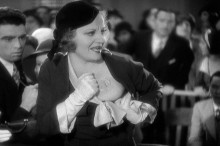
The set starts with one of a handful of films directed by Broadway legend George Abbott, The Cheat (1931). It’s not a bad film. It moves surprisingly well for its year. In point of fact, it’s a remake of DeMille’s famous 1915 film of the same name about a society woman who loses charity money and accepts a “loan” from a wealthy Japanese man (Sessue Hayakawa) with herself as collateral. Of course, he doesn’t want repayment, he wants her. It all ends up with him branding her, a trial for her shooting him and his comeuppance at the hands of an outraged mob. The 1931 film makes one very significant change—the wealthy man is now a white gent with a taste for Oriental culture. That’s probably less the code than just good sense on the filmmakers’ part. Otherwise, the stories are largely interchangeable—complete with Tallulah Bankhead’s society wife being branded and all the scenery chewing La Bankhead can muster (and it’s a lot) in the big courtroom scene.
Dorothy Arzner’s Merrily We Go to Hell is less worthwhile—probably because it’s a Dorothy Arzner film. Arzner was never a very creative or interesting filmmaker and apart from some unusually fluid tracking shots (mostly early in the film) that holds true here. In fact, it’s hard not to suspect that those shots had more to do with the Paramount “look” on the era than with her direction. To be fair, the material—even with Fredric March and Sylvia Sidney—is pretty dire. It’s really little more than a cautionary tale about drinking and modern life that would have been more at home coming from a mid-cult studio like MGM than sophisticated Paramount.
More interesting, though probably not much better on its actual merits, is William A. Seiter’s Hot Saturday. The title appears to refer to the day of the week that the young people in a small town go to a lake for prohibition drinking and petting parties. But there’s a wrinkle in that filthy rich playboy Cary Grant has his eye on bank employee Nancy Carroll so he invites the gang to his place. Complications ensue that ruin Carroll’s reputation and get her fired for immorality, which she tries to fix by settling on a quick marriage to visiting geologist—and old family friend—Randolph Scott. That falls apart when he learns about her actually innocent night with Grant. The upshot of this is probably the most interesting part of the film, but I’ll leave it to the viewer to be surprised by the ending (I was).
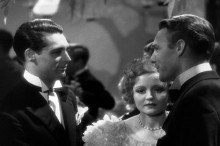
Seen today, Hot Saturday is a little quaint, but it’s also of some interest as concerns the hypocrisy and underside of a supposedly innocent small town existence (think of it as a very light Blue Velvet in that regard). For Paramount scholars, it’s intriguing for having a soundtrack that appears to be determined to promote sales of every tune from both of Maurice Chevalier’s 1932 movies. And, for those with a taste for unconscious humor, there’s the scene where Cary Grant and Randolph Scott size each other up—supposedly as rivals for Nancy Carroll. Knowing what we know today—when we’re less likely to buy into the idea the studio sold to the fan mags that Grant and Scott were living together to save expenses—it’s hard to look at this business in quite the same light.
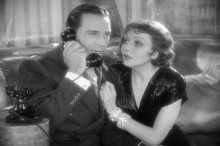
Torch Singer (1933) is an engaging oddity that stars Claudette Colbert in an unwed mother yarn that turns into an unwed mother-love yarn with glimpses of high and low life in Manhattan. As a bonus we get Colbert warbling (there is no other word for it) “Give Me Liberty or Give Me Love,” a brazen statement that she’s willing to give-out if her man will just be faithful. The cast is better than the material. Colbert is especially good at making you believe every bit of soap, and David Manners gives what may be his most natural performance as the rich boy who impregnated her and then ran off to (yes) China. What’s really pre-code about it—apart from the tone and Colbert’s alarmingly realistic drunk scene—is the ending. Unwed mothers were a dime a dozen (even post-code, they made great object lessons), but unwed mothers with a happy ending? No, that wasn’t happening, even if it does in this case.
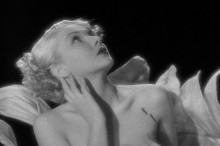
The best film in the set is Mitchell Leisen’s Murder at the Vanities (1934), a pretty decent backstage mystery with a solid cast—apart from the colorless lead, Carl Brisson—some good tunes including “Cocktails for Two” and “Ebony Rhapsody,” not to mention Gertrude Michael singing “Sweet Marihuana,” and a whole lot of scantily-clad chorus girls. It’s hard-edged fun all the way—even if it’s impossible not to wish that Bela Lugosi had been imported from the stage version. It’s also good filmmaking from Leisen (who can be seen briefly as the orchestra conductor) on his third solo film—and a more different work than his previous film, Death Takes a Holiday (1934), could hardly be imagined. The highlight is probably Duke Ellington and his Orchestra playing “Ebony Rhapsody,” which climaxes with outraged classical musician Charles Middleton machine-gunning everyone.
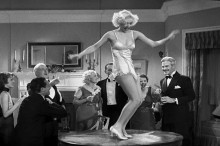
The worst movie in the lot is Erle C. Kenton’s Search for Beauty (1934). It’s also the most perversely fascinating. This is pure exploitation movie any way you look at it. It seems to think its expressing outrage over innocent athletes being duped into posing for indelicate photos to be ogled in print. And how does it express this outrage? Well, by showing these innocent athletes in various stages of undress, of course. The whole thing appears to have been done to cash in on Olympic athlete Buster Crabbe and the fact that the studio had footage of the 1932 Olympics that were conveniently held in Los Angeles. All in all, it’s somewhere in between dumb and insane with its calisthenics a la Busby Berkeley approach and its patent ogling of all this young flesh. While bits of nudity are not hard to find in pre-code films, this has the most I can recall—especially the most beefcake, including a shower room scene that I had to look at twice to be sure I hadn’t imagined it.
Would I recommend this set? For students of the era, yes. Also curiosity seekers may find it of more than a little interest. It’s probably worth it just for Murder at the Vanities—and it’s definitely worth it just to keep the studios interested in marketing these obscurities. What I do not recommend, however, is taking either this, or the MGM sets as the definitive word on the world of the pre-code film. There’s much more to the era than these samplings prove.




Actually, those 3 pre-code sets are from Warner Brothers, not MGM, although they may contain some MGM films.
Interesting article. Thanks for the little history lesson. I always enjoy reading about how historical accounts have been manipulated by the powers that be. It’s enjoyable to feel like I am part of a select few who know the ‘true’ history. If your interested, “Lies My Teacher Told Me” by James Loewen, is an intriguing book to read about how textbook authors propagate factually false, eurocentric, and mythologized views of American history. Also, have you seen the movie “This Film Is Not Yet Rated”? It’s an independent documentary about the MPAA that someone recommended to me, but I have not yet seen it.
Actually, those 3 pre-code sets are from Warner Brothers, not MGM, although they may contain some MGM films.
That’s what I get for not digging out the one I have. This stuff changes hands so much these days and with Warner Bros. owning MGM titles and MGM still owning the UA titles and so on, it gets confusing. At one point there were things labeled MGM classics that were in fact old WB pictures.
Interesting article. Thanks for the little history lesson. I always enjoy reading about how historical accounts have been manipulated by the powers that be. It’s enjoyable to feel like I am part of a select few who know the ‘true’ history.
A lot of what happens with film history (in part because it’s not considered that important in many quarters) is that one piece of misinformation gets into a reference work and then gets cited by someone else and on and on and on. This was particularly true in the 1960s when there were so many movie books being put put out. A lot of these were slipshod affairs consisting of little more than credits, plot synopses, reviews from the era the film was released and lots of photos. The credits were often inaccurate and the plot synopses frequently came from studio blurbs that were written before the movies were made (the synopsis of Alice in Wonderland in The Films of W.C. Fields bears almost no relation to the actual movie).
Some things are merely writers repeating things they’d heard. If, for example, I just assumed that my mother was right when she told me about the word “damn” in GWTW, I might hold the common viewpoint. Well, my mother was born in 1928, so she never saw — or wouldn’t have remembered — the pre-code movies, but she would remember the fuss about the line in GWTW. I’m sure things like that are the innocent origin of many mistakes.
an intriguing book to read about how textbook authors propagate factually false, eurocentric, and mythologized views of American history.
Hardly surprising. The sins of omission in history books are many, for starters. And it happens in part because of where you live. The classic example is Benedict Arnold. You don’t really think he’s called a traitor in British or even Canadian history books, do you?
Also, have you seen the movie “This Film Is Not Yet Rated”? It’s an independent documentary about the MPAA that someone recommended to me, but I have not yet seen it.
I haven’t seen it, but I have heard of it. I know that John Cram wanted to run it at the Fine Arts (I think he’d seen it at the Toronto Film Festival), but for whatever reason (probably it fared badly at the box office in release) that never happened.
Also, have you seen the movie “This Film Is Not Yet Rated”?
It’s decent…does a pretty good job of unspooling the arbitrariness of the American movie rating system–the most revealing thing to my way of thinking is how few people actually collectively weigh in and impact the final rating a movie receives; nevermind how laughable it is the notion that one of the primary so-called defenses standing between parents protecting/guiding their children toward and away from irresponsible viewing choices is this group of dimwits and soccer moms locked in a sterile conference room located in a strip-mall.
As far as pre-code goes: A recommended introduction to pre-code movies for the uninitiated is BABYFACE starring B. Stanwyck–oooh-la-la!–and a glimpse of an unknown actor named John Wayne (in a suit). Stanwyck literally sleeps her “way to the top” of the corporate food-chain one office floor at a time.
“Yeah, I’m a tramp, and who’s to blame? My Father. A swell start you gave me. Ever since I was fourteen, what’s it been? Nothing but men! Dirty rotten men! And you’re lower than any of them. I’ll hate you as long as I live!”
Also, for those that haven’t seen it, FEMALE (The 1933 title says everything you need to know)with Ruth Chatterton is not to be missed–Directed by Michael Curtiz. Check out the runtime–60 minutes.
Another aside related to movies from this era that caused me to do a double-take: With the making of the pre-code gangster movies–like, say, THE PUBLIC ENEMY, the studio would bring in sharpshooters to “strategically” fire upon Cagney and the like during filming because the phony bullet “squibs” hadn’t been invented/adopted by that point (1931).
Talk about calling for “Action” on the set!?!?
A recommended introduction to pre-code movies for the uninitiated is BABYFACE starring B. Stanwyck–oooh-la-la!–and a glimpse of an unknown actor named John Wayne (in a suit). Stanwyck literally sleeps her “way to the top” of the corporate food-chain one office floor at a time.
And if memory serves, she doesn’t come to a bad end because of it all.
Also, for those that haven’t seen it, FEMALE (The 1933 title says everything you need to know)with Ruth Chatterton is not to be missed–Directed by Michael Curtiz. Check out the runtime–60 minutes.
Female is particularly noteworthy because it presents the same kind of sexually aggressively woman that one finds in the Mae West comedies, but in more dramatic — and somewhat deeper — terms.
With the making of the pre-code gangster movies–like, say, THE PUBLIC ENEMY, the studio would bring in sharpshooters to “strategically” fire upon Cagney and the like during filming because the phony bullet “squibs” hadn’t been invented/adopted by that point (1931).
It wasn’t a film that I mentioned specifically (all pre-code gangster films tend to seem a little tame next to Scarface), but this is also noteworthy in pre-code terms — especially that ending. Since that ending couldn’t be cut out (re-editing pre-code films was common practice years later), WB got by on re-issues by prefacing this film (and Little Caesar) with some high-toned moralizing about highlighting a public issue.
It was nice to read information of substance without someone ridiculing the topic.
I love the freedom of digital photography but enjoy working the live elements into the filming.
Mae West was one of the first to make Sex talk able in public.
Thanks again for the info!
Mae West was one of the first to make Sex talk able in public
She was indeed — and one of the first to dare to suggest that sex might be fun. She may be the first woman in the history of film to actually verbalize the idea of a woman looking at a man as a sex object. While reasonably open displays of lust weren’t all that uncommon, I can think of no other woman of her era who would’ve dared size up Randolph Scott and ask someone, “Who’s the young man with the large and sinewy muscles?”
I think one goal from a good documentary is able to bring up debate and change. THIS FILM IS NOT YET RATED did just that. After this film, the MPAA retooled their policies a little to where now a filmmaker can appeal the original rating.
I hope some of these movies show nekkid men.
I hope some of these movies show nekkid men.
Search for Beauty certainly does.
I’d be surprised if there is any demand for these old movies. I still wouldn’t mind reading one of their books on a pre-code movie.